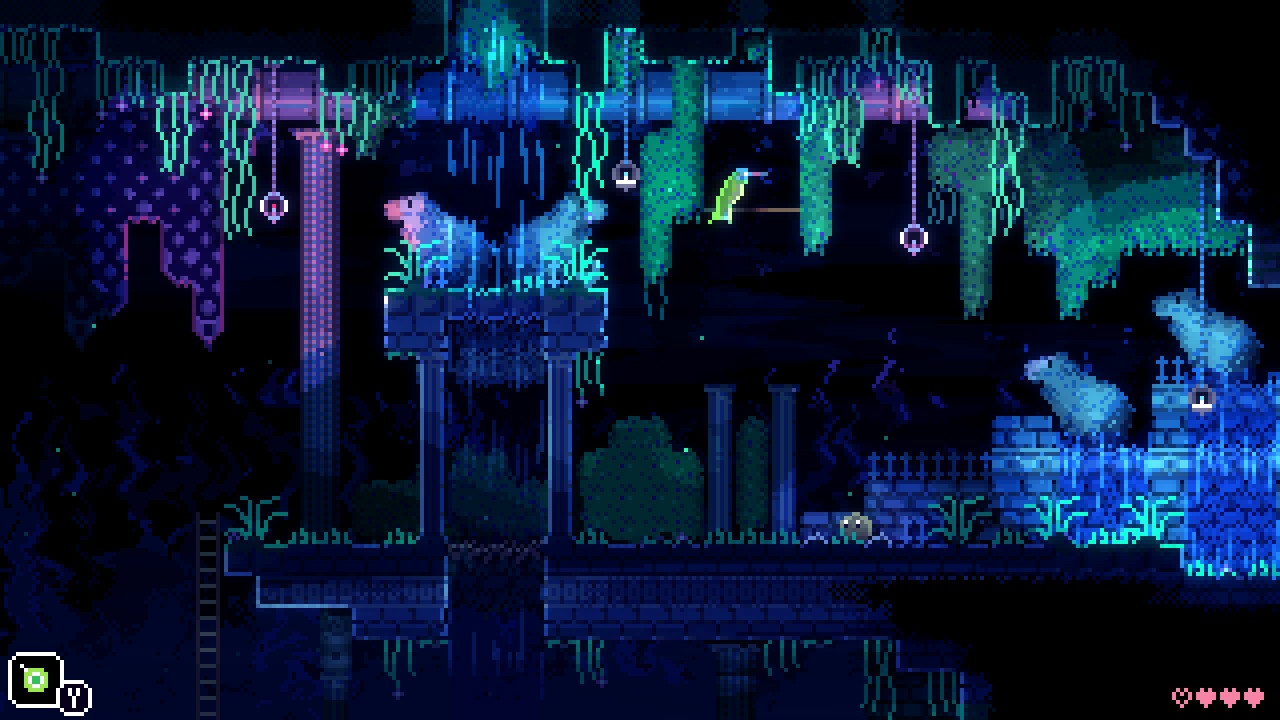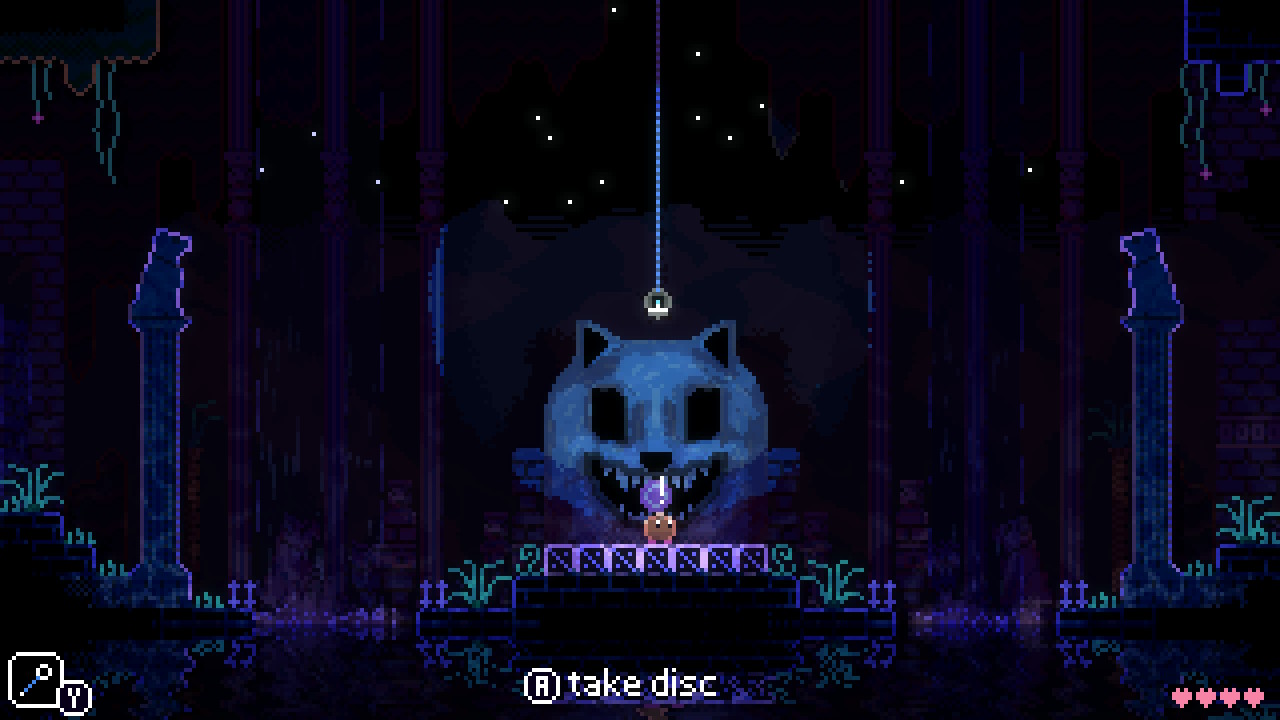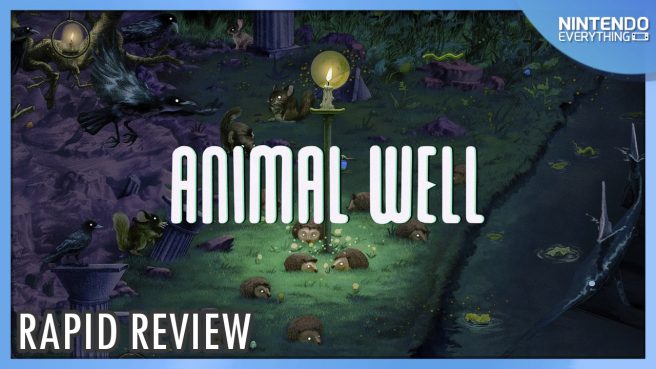[Rapid Review] Animal Well
System: Switch
Release date: May 9, 2024
Developer: Billy Basso
Publisher: Big Mode
Writing a review for a game like Animal Well is difficult, because with each new piece of information you’re given it lessens the experience: it’s one less discovery that you can make for yourself, one less light-bulb moment of pure satisfaction you’ll get from correctly interpreting what the game is subtly guiding you towards doing without you even realizing it until after you try something and, miraculously, it works. My experience with the game was made up of these moments, one after another, in almost every room I entered. It’s a highly rewarding experience, and I don’t want to ruin any of it for those who are even remotely curious about picking this game up. But I’ll try and give you a brief overview and reason enough to give into that curiosity, because it might just be one of the best gaming choices that you make this year.
Animal Well is a Metroidvania with a strong emphasis on exploration and environmental puzzles: you’ll be doing a lot of backtracking to advance, with many puzzles spanning several rooms and requiring you to hit switches in a certain order, or activate mechanisms, before you can advance. It’s a gloomy, oppressive environment that you’re tasked with exploring, and one that never fails to make you feel vulnerable, but also strangely empowered each time you successfully overcome one of the challenges it presents. Despite the lack of guidance that it gives you, the game is remarkably intuitive, and favors a show and don’t tell design philosophy, leaving it to the player to intuit their surroundings and how to progress. This can result in a lot of trial and error that may prove frustrating at times, but the solution to a problem is never overly obscure, even if it does often require a very roundabout way of doing things.
Your player character, a small and featureless blob, hatches from an egg in the dark, seemingly alone, voiceless, and entirely without guidance or any kind of context for their situation. Who are you? How did you get here? What are you supposed to do, and why? All that Animal Well gives you to work with – and all that it will ever give you directly – is a blank map, to be filled in as you explore, complete with four markers, to move towards or ignore as is your preference. It’s a helpful anti-frustration feature that allows you to keep track of your progress, and an objective to work towards if you happen to get lost along the way: as long as you move towards one of those four icons, you’re probably making some progress. You can approach them in any order you choose, and although you will find yourself initially restricted in where you can go due to needing to acquire some tools to aid in your progression, once you have these the entire map opens up to you.

You’ll find only a small number of items to aid in your platforming and puzzle-solving capabilities (many of these are actually optional and you may never find them at all) and these are both wonderfully unique and creative in how you can use them to interact with the environment. All of them have their obvious and immediate uses: the Bubble Wand can help you cross larger gaps, and the Yo-yo will let you hit switches that are farther away, for example. When first acquiring an item the game will usually have either been hinting that you’ll need it in order to progress, or will immediately present you with a situation where you’ll need to use it; perhaps the only instances where it almost features what would be tutorials in a more hands-on title. Beyond this initial introduction however, how you can use the items is left for you to discover, and they have plenty of other uses outside of the obvious. More than once when I was exploring and found myself stuck, using one of my tools in an unorthodox way was what allowed me to progress, and using a tool would also occasionally lead to discovering something I was previously unaware of. Although experimentation isn’t always rewarded, it is always encouraged.
Tools are used primarily for puzzle solving and platforming however, and don’t have any directly offensive capabilities. Since you are unable to attack any hostile creatures that threaten you, you’ll need to rely on your wits in order to overcome them. Some will run from you, others will ignore you unless you get too close, and some will seek you out immediately and chase you with a persistence that can be maddening, sometimes across multiple screens. Some can be distracted, and others can be scared off by throwing firecrackers at them – your only limited-use item that can occasionally be picked up from your surroundings, making them an often valuable commodity you’ll likely want to hoard for such encounters – but most can only be avoided. Each one needs to be approached differently, with a few even needing to be used to your advantage to activate switches or cross hazards. The various creatures you’ll encounter are always a noteworthy occasion, being the only other sign of life and often changing up the gameplay flow dramatically when they don’t immediately run from you; it’s rare that you’ll be able to simply ignore them and carry on, and many act as environmental puzzles themselves.

At times I did feel that the platforming could border on being unreasonably difficult, even frustrating, due to some very strict timing and precision. This is not helped by the lack of checkpoints between jumps, although as you usually won’t lose health when dying from a fall this is at least mitigated to some extent. It never feels as though the game is deliberately placing artificial difficulty spikes in your way, and in most instances if something proves to be slightly more difficult to accomplish it’s an optional challenge, usually for a chest containing one of the many egg collectibles hidden away as a prize for those willing to explore, or boldly placed out in the open behind a series of tricky jumps or obstacles for the daring to claim if they can.
The visuals match the overall level design, being simple and beautiful, yet packed with hidden details. Despite the general gloomy atmosphere the game is never too dark, and has some impressive lighting effects that never makes it too difficult to distinguish your surroundings, even during those rare occasions when the darkness makes it impossible for you to see the map. There is an impressive amount of animation to the environment that makes the empty areas come alive, with plants rustling as you move through them, and water shimmering and moving constantly in the background. Sound effects are particularly noticeable in the game due to an almost complete absence of background music much of the time, which makes you pay attention to the slightest of noises: the drip of water, the distant howls of cats and dogs, and the movement of your own character. It makes the game relaxing, eerie, and sometimes outright terrifying, and complements its more minimalistic nature perfectly, letting you sense the mood rather than boldly forcing it upon you with music.
The Verdict

Although it may frustrate at times due to its occasional challenge and more indirect method of communication that can just as easily leave you feeling like an idiot as it can a genius, Animal Well never fails to impress, and from the moment you hatch to the credits roll (and beyond, if you wish to keep exploring) there are challenges and surprises around every corner. It’s a rare game that rewards you for exploration and ingenuity, teaching you through fantastic level design that makes every achievement your own, and every small victory and payoff worthwhile. It’s something you need to discover and experience for yourself, and I strongly recommend picking it up.
Animal Well copy provided by the publisher for the purposes of this review.
